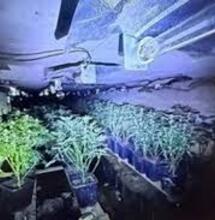Damping-off

Damping-off kills seeds, seedlings and clones. It can also attack buds and stems (Botrytis cinera). There are two kinds of damping off one kills seeds when they germinate and before they break through the soil. The second post/emergence damping-off is the rotting or wilting of seedlings soon after they emerge from the soil.
Damping-off kills seeds, seedlings and clones. It can also attack buds and stems (Botrytis cinera). There are two kinds of damping off one kills seeds when they germinate and before they break through the soil. The second post/emergence damping-off is the rotting or wilting of seedlings soon after they emerge from the soil.
Damping-off kills seeds, seedlings and clones. It can also attack buds and stems (Botrytis cinera). There are two kinds of damping off one kills seeds when they germinate and before they break through the soil. The second post/emergence damping-off is the rotting or wilting of seedlings soon after they emerge from the soil. Succulent stems have water-soaked then necrotic and sunken, zone at ground level, the little herbaceous plants fall over the ground. Root decay follows.
Damping-off attacks rooting cuttings at the soil line if present in growing medium. As the fungi invade stem tissue it loses girth at the soil line, weakens, then discolors with a brown watery soft rot, and finally fluid circulation is cut, killing the seedling or cutting. It prevents newly sprouted seeds from emerging, and attacks seedlings causing them to rot at the soil line, yellows foliage and rots older plants at soil line.
Damping-off is caused by different fungal species, including Botrytis, Pythium, and Fusarium are present in the air, growing medium plant or seed. This disease breeds in wet, poorly aerated over-watered growing mediums, humid conditions and attacks weak plants.
Prevent damping-off by controlling soil moisture. Overwatering is the main precursor to damping-off. Careful daily scrutiny of soil will ensure the proper amount of moisture is available to seeds or cuttings. Start seeds and root cuttings in a fast-draining, sterile coarse sand, rockwool, OasisTM, or JiffyTM cubes, which are difficult to overwater. Set them on a grate or surface that readily drains. Do not place a humidity tent over sprouted seedlings-a tent can lead to excessive humidity and damping-off. Damping-off is inhibited by bright light; grow seedlings under the HID rather than fluorescent bulbs. Keep fertilization to a minimum during the first couple weeks of growth. Germinate seeds between clean, fresh paper towels and move seeds to soil once sprouted. Do not plant seeds too deeply, cover with soil the depth of the seeds. Use fresh, sterile growing medium and clean pots to guard against harmful fungus in the soil.
Coat seeds with protective dust for insurance. Seed disinfection is used to kill organisms of anthracnose and other species diseases carried on seed. Damping off organisms are in the soil, not on the seed. The coating is intended to kill or inhibit fungi in the soil immediately surrounding the seed and so provide temporary protection during germination.
Cuttings are less susceptible to damping-off and love a humidity tent to promote rooting. Keep germination temperatures between 21-29°C. Be very attentive to soil moisture and overall clone health.
Control damping-off biologically in seeds with Polygangron® (Pythium oligandrum) granules to soil and seed. Bak Pak® or Intercept® are applied to the soil and Deny® or Dagger®-forms of the bacterium Burkholderia cepacia-are put on the seeds. Epic®, Kodiac®, Quantum 4000®, Rhizo-Plus®, System 3®, and Seranade® also suppress many causes of damping- off.
Chemical controls include dusting with Captan®. Avoid benomyl fungicide soil drench because it kills beneficial organisms.
Powdery Mildew
Mildews are called "powdery mildew" among cannabis growers. This term encompasses all mildews. Mildew grows on foliage, leaves and buds. Most look like foliage was sprinkled with fine flower or talcum powder. It drains the vigor of plants, and can pose a health risk to smokers with lung ailments. Every year powdery mildew destroys a growing percentage of cannabis crops.
The first indication of infection is small spots on the tops of leaves. Next a powdery looking substance (flowering fungus) appears on foliage. At this point the systemic disease has been inside the plant a week or more and the disease can be only arrested by external treatments but not eliminated. Spots progress to a fine, pale, gray-white powdery coating on growing shoots, leaves, and stems.
Damage caused by powdery mildew is subliminal during the first month or two after infection. Powdery mildew is not only on the upper surface of foliage, it is found throughout the plant. It causes growth to slow, leaves to yellow, and plants eventually die as the disease advances. Occasionally fatal indoors, this disease is at its worst when roots dry out and foliage is moist. Plants are infected for weeks before they show the first symptoms.
Mildew is caused by one of the many different species of fungi from the order Erysiphales. Spores are present in the air all the time. Often these spores enter the grow room and greenhouses. They find cool moist grow rooms with poor circulation the perfect place to live.
Preventing powdery mildew is the best policy. Once established, mildews must be eliminated from an empty grow room. They cannot be eliminated from plant tissue without the help of a systemic chemical. Cleanliness! Prevent this mildew by avoiding cool, damp, humid, dim grow room conditions, as well as fluctuating temperatures and humidity. Low light levels and stale air affect this disease. Increase air circulation and ventilation, and make sure light intensity is high. Space containers far enough apart so air freely flows between plants. Allow foliage to dry before turning off lights. Remove and destroy infected foliage. Avoid excess nitrogen. Copper and sulfur-lime sprays are a good prophylactic and potassium bicarbonate is effective as a surface fungicide.
Quarantine new clones brought in from outside the grow room for a week or two. If buying clones at a dispensary, hydroponic store or if acquired from friends, isolate the clones for a week to see if they have powdery mildew and other diseases or pests before introducing them to the main plant population. Dip clones in a prophylactic organic bath before introducing them to the grow room.
Sulfur products such as, Safer's Defender, prevent powdery mildew on contact with foliage, but the disease is still inside the plant. Applying sulfur make the cannabis taste bad when smoked. It appears to concentrate on resins. Chimera, an outstanding breeder, grower and friend, does not recommend using sulfur on vegetative or flowering plants. He recommends using a sulfur burner in a room to kill all mildew when no plants are in the room.
Apply Serenade® (Bacillus subtilis) or spray with a saturation mix of baking soda and water to kill surface contamination to keep the disease in check. Copper-based sprays may keep this mold in check. A saturation of baking soda spray dries to a fine powder on the leaf; the baking soda changes the surface pH of the leaf to 7, and powdery mildew cannot grow. An organic "systemic" called Aqua-Shield is available from Botanicare that have had very favorable reports. A mixture of 10-20 percent milk and 80-90 percent water is also effective, but it smells bad.
Destroy damaged plant material.



